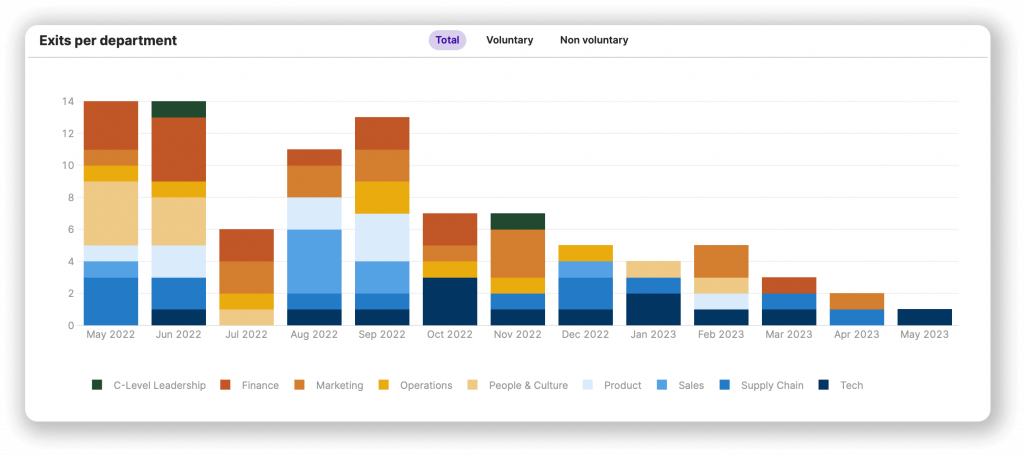We are excited to announce our €2.3 Million Pre-seed round led by Earlybird-X! →
You are responsible for people analytics: But how to get started?
02 Feb

The strategy for 2023 is set, the OKRs/goals for HR are defined, and the topic of reporting & analytics is on your agenda – Congrats!
Many people analytics leaders find themselves in the same situation. What’s the best way to get started? How do I make sure my initiative is a success? As a teaser, immediately talking about “advanced predictive analytics” and using AI drastically decreases your chances of success.
Let’s face reality: Poorly managed data, disconnected systems, multiple stakeholders with different requirements, and resistance from within the organization are not uncommon and something you should expect.
But there’s no need to panic. We’ll show you ways to ensure the long-term success of your initiative and enable data-driven HR decisions. Let’s start with the basics – the data.
Data
Right off the bat, the first challenge arises. How do I get access to the right data to drive relevant metrics and decisions?
Democratization of data is the key word here – make sure you get access to the raw data from the various systems and conceptualize the distribution and sharing of that data into the organization right away in your people analytics initiative. Therefore, consider at the very start who the relevant stakeholders are and what data should and may be shared at what level of aggregation.
It is also important to keep the scalability of the process in mind and to think about the integrations of the data from the different systems, cleansing, normalization and transformation of the data.
Having the right data is fundamental to starting People Analytics. Important data sources for your initiative are usually the HCM system (number of employees, attrition rates, compensation, etc.), an ATS system (applications, interview days, recruiting channels, etc.), performance & engagement systems (eNPS, feedback, surveys) and business systems (e.g. CRM/sales systems, productivity system, etc.).
Get an overview of your initiative’s tech stack, data sources, and relevant stakeholders at the beginning.
Context
For your initiative to be a success, it is important to understand who the users of your “dashboard” are – they will ultimately decide the value that People Analytics delivers. Two important points to understand here:
– Context of the organization/stakeholder
– Context of the data
First, look at the total cost of the workforce – it’s not uncommon that your workforce costs account for up to 70% of an organization’s total costs. Your People Analytics initiative enables data-driven decision-making for 70% of your organization’s investments. Seek to understand the organization’s strategy and priorities early on so that you can use People Analytics to directly add value to the organization by enabling the best (data-driven) decisions to be made.
Second, give the right context to the data. Numbers alone do not provide interpretations and recommendations for action. It is not enough to simply send nice-looking dashboards to the various stakeholders. Often, without context, they can’t interpret the data correctly and make the right decisions from it. Therefore, it is essential to include target values, benchmarks and trends to create the right context for the data.
Story
To have a lasting impact on the organization, the story is crucial in addition to the context of the data and the organization. Data can tell the story of the organization’s evolution from the past, present, and future. Your stakeholders like to understand if certain decisions have impacted the organization positively or negatively, what lessons have been learned, and what actions have resulted in a positive ROI. This way, your stakeholders can directly understand what the historical trajectory is, what current situation the organization is in, and what indicators provide an outlook about the future. This leads to significant added value in the organization through data-driven decisions – your goal as a people analytics leader.
We hope the article helps you to get a first overview of the important steps for your successful People Analytics initiative and to set the right priorities. In the future, we’ll delve deeper into each of these areas so that your initiative leads to success.
You are curious?
peopleIX connects all your HRIS, ATS and other HR data sources to create a unified view of your workforce. Get a personalized demo around your unique pain points and discuss your company’s specific needs. Find out how peopleIX can help you on your people analytics journey. Or discover our use cases in the areas of people, recruiting, retention and DEI.
Recent Posts

Insight: Gender Pay Gap
February 12, 2025
The Challenges of People Analytics
November 12, 2024
People Analytics: Benefits, Origins & Best Practices
November 12, 2024Categories
- Analytics (2)
- Collaboration (1)
- Customer Sucess Stories (1)
- Data Management (1)
- Foundations (9)
- Human Resources (HR) (3)
- Platform (1)
- Recession Times (2)
- Tech Stack (1)
- Uncategorized (7)
- Use Cases (4)
PRODUCT
People Planning & Scenarios
Sharing & Collaboration
RESOURCES
STAY IN THE LOOP
Copyright © 2024 peopleIX GmbH. All rights reserved.



